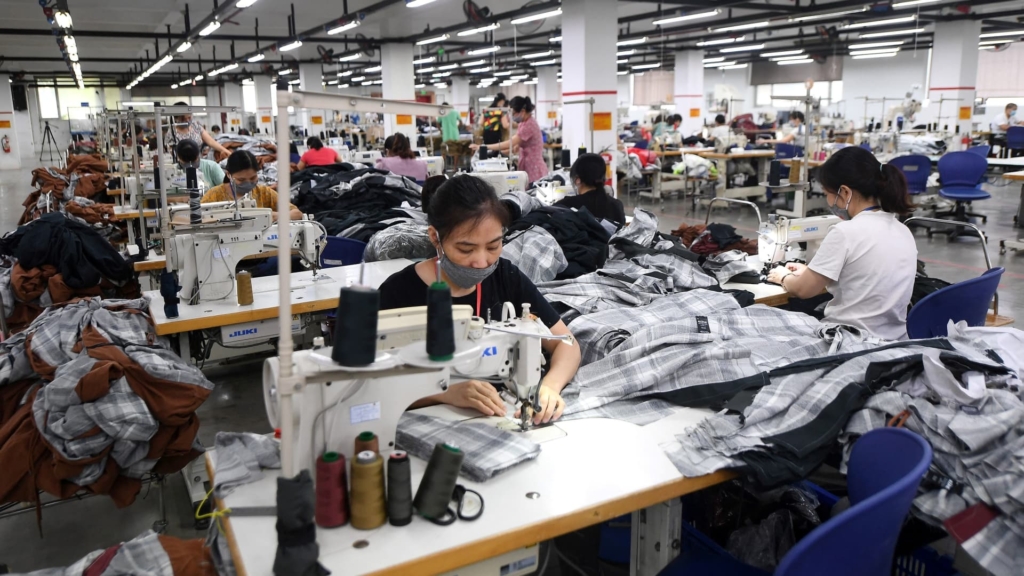As manufacturers and retailers seek alternatives to China for production, Vietnam has become a favored destination for producing goods ranging from sneakers to furniture.
Vietnam’s ascent as a prominent manufacturing hub has been particularly significant amid the ongoing U.S.-China trade tensions. However, with President Donald Trump widening the scope of his trade war, companies now face new challenges in their efforts to pivot away from China.
On Wednesday, Trump announced a substantial 46% tariff on imports from Vietnam, set to take effect on April 9. This new wave of tariffs could significantly increase costs for major corporations in sectors such as apparel, furniture, and toys, potentially leading to higher prices for consumers.
For over two decades, China has been the dominant exporter to the United States, but recent data indicates that Mexico has now overtaken China as the largest source of imports in 2023. According to the Office of the U.S. Trade Representative, China has slipped to being the second-largest supplier, exporting $438.9 billion worth of goods to the U.S. in 2024.
Retailers aiming to diversify their manufacturing bases to mitigate risks associated with trade disputes with China have increasingly turned to Vietnam. Import figures reveal a notable growth from Vietnam, which reached $136.6 billion in 2024, marking a 19% increase from the previous year.
In stark contrast, imports from China saw only a modest increase of 2.8% from 2023 to 2024, following an 18% decline recorded the previous year. As inflation continues to exert pressure on consumers, businesses may find themselves caught in a difficult position, facing the prospect of absorbing increased costs or passing them on to price-sensitive customers.
While it remains uncertain which companies will opt to raise prices, many may hesitate to do so amid projections of subdued consumer spending in the near term.
The companies most vulnerable to Vietnam tariffs
Notable brands are bracing for the impact of the tariffs, with Nike being particularly exposed, as it sources approximately half of its footwear from China and Vietnam, about 25% of which comes from Vietnam. In light of the new tariffs, Nike faces a 54% effective tax rate combining existing duties on imports from both nations.
This latest development adds pressure to Nike, which has already reported a disappointing sales forecast projecting a double-digit decline in the upcoming quarter, taking the tariffs into account.
Shares of Nike fell nearly 12% in trading on Thursday, with other major players in the footwear industry, such as Adidas, closely monitoring the situation. Adidas has indicated it will evaluate the potential impact of these tariffs, while Nike has not yet commented on the matter.
Recent data from the Footwear Distributors and Retailers of America reveals that in 2023, nearly a third of footwear imports to the U.S. were sourced from Vietnam, making the implications of these tariffs particularly significant.
Matt Priest, CEO of the Footwear Distributors and Retailers of America, expressed concern over the tariffs, stating, “This policy is catastrophic for American families,” particularly as the industry grapples with ongoing inflationary pressures.
Steve Madden has recently indicated plans to reduce its imports from China by as much as 45% over the next year, with Vietnam emerging as a favored alternative alongside Cambodia and Mexico.
Deckers Brands, known for UGG and Hoka, also relies heavily on Vietnam, with this country being its second-largest source for suppliers. Deckers shares dipped over 15% following the tariff announcement.
VF Corporation, home to brands like The North Face and Vans, finds itself similarly exposed, with significant sourcing from both China and Vietnam. VF’s stock experienced a sharp decline of over 25% amid market reactions on Thursday.
The furniture sector has increasingly turned to Vietnam as well, with 26.5% of U.S. imports originating from the country in 2023, placing it closely behind China. Collectively, over half of U.S. furniture imports now come from these two regions.
Wayfair’s CEO noted a marked trend toward sourcing from countries outside China since the implementation of tariffs during Trump’s first term. The company acknowledged the stock had fallen nearly 28% during the recent trading session.
Vietnam’s manufacturing growth has also been evident among toy manufacturers like Hasbro and Mattel, who are turning to production facilities in Vietnam as part of their supply chain strategy.
Funko’s CFO highlighted efforts to manage the impact of tariffs by renegotiating costs and adjusting pricing strategies, noting that approximately a third of the company’s purchases come from China. On a similar note, shares of major toy companies, including Mattel and Hasbro, also experienced declines of over 10% on Thursday.
Curtis McGill, co-founder of toy company Hey Buddy Hey Pal, anticipates that the tariffs will lead to increased costs for consumers while manufacturers negotiate with Vietnamese suppliers to mitigate the impact.
Where do manufacturers go next?
With the evolving tariff landscape, companies are reassessing their manufacturing strategies. During a recent earnings call, American Eagle Outfitters executives discussed their plans to reduce production reliance on Vietnam and China to single digits by year-end.
The retail giant’s stock fell by more than 16% on Thursday as it navigates the uncertain policy environment. American Eagle’s leadership underscored the importance of flexibility in responding to these changes.
Peter Baum of Baum Essex argued that the reciprocal tariffs pose a severe threat to companies like his, calling it a potential start to economic regression. Baum previously transferred factories from China to countries such as Vietnam and Cambodia to mitigate risks.


























